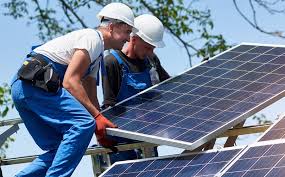Solar electricity systems pre-installed on new homes must be a mainstay of beefed-up building regulations, MPs on Parliament’s environmental audit committee were told yesterday.
Ian Rippon, CEO of technical standards assurers the MCS, told the committee that photovoltaic panels on home rooftops “as a mainstay of the Future Homes Standard is critical”.
Presented by the government as the biggest re-think yet of much criticised, seldom enforced building controls, the Future Homes Standard is intended to improve Britain’s notoriously lax standards of home insulation, and ease dwellings towards Net Zero compliance. Implemented in part since June, the new measures’ full introduction is scheduled for 2025.
“The problem now is that it’s – (PV installation) in pockets, depending on local building regulations”, Rippon explained.
Beside him, Chris Hewett, boss of lobbyists SolarEnergyUK, said industry expectations now are that “pretty much every English home built from 2025 will have some solar generation capacity”.
The government’s Energy Generator Levy, a windfall tax on the sector now facing at least one challenge in the courts, Hewett described as “a mistake”, producing an “unlevel playing field”. It gives solar developers no incentive to offset it through investment, said the lobbying boss, despite Britain’s dire need to be weaned off natural gas.
Quizzed on UK-wide targets to have 70GW of solar power capacity generating by 2035, – against 15.5GW today including farms – , Hewett replied that the aspiration was “definitely enough… and it’s feasible”.
Solar’s projected rise to contribute 10% of Britain’s power demand, up from 4% now, is needed to meet national needs growing from increasing electrification of heating, homes and transport, the PV industry believes.
Installers and suppliers expect about two-thirds of UK solar PV capacity by 2035 to come from ground-mounted racks, with residential and commercial roofs providing the rest. Floating solar farms, such as on a Thames Water reservoir near Heathrow airport, could contribute after 2035, said Hewett.
Written evidence cited by Anna McMorrin MP warned that grid connections are not speeding up. Farm developers face waits well into the 2030s. The MP described the National Grid as a “pretty broken system”.
Regional targets for grid connections could spur DNOs to respond quicker, Alastair Buckley, Sheffield University’s professor of organic electronics believed.
Committee chair and Conservative MP Philip Dunne later suggested that grid access could be the subject of its own dedicated inquiry.
Green MP Caroline Lucas suspected so-called Smart Export Guarantees offered by power retailers are too miserly to woo homeowners into solar adoption. MCS boss Rippin agreed. “It’s been taken over by the economics of cheaper solar. There is a problem of fairness” he added.
Cheap capital is needed to spur homeowners to install PV, Hewett told MPs. He cited 0% loans made available by Scotland’s government for insulation, as well as retro-fitting PV & heat pumps.
Dr Chris Case leads technology innovators at Oxford PV. Two years ago, the firm’s perovskite enhancement pushed standard silicon cells to a record conversion efficiency of over 29%. That’s fully a third better than current standards on the world’s roofs.
Case described as “perverse” the Treasury’s treatment of VAT on home batteries storage systems. Homeowners must shoulder the tax’s 20% burden when adding a battery to pre-installed panels. Installing both at the same time attracts no VAT.




